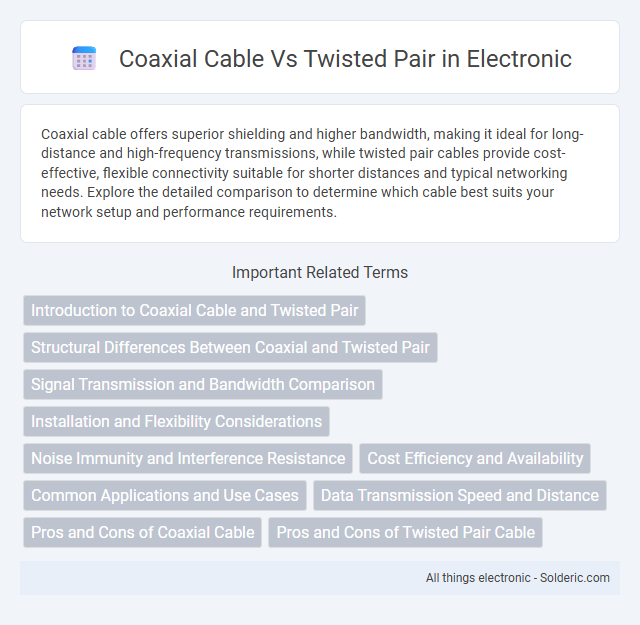Coaxial cable offers superior shielding and higher bandwidth, making it ideal for long-distance and high-frequency transmissions, while twisted pair cables provide cost-effective, flexible connectivity suitable for shorter distances and typical networking needs. Explore the detailed comparison to determine which cable best suits your network setup and performance requirements.
Comparison Table
| Feature | Coaxial Cable | Twisted Pair |
|---|---|---|
| Structure | Single copper conductor with insulating layer and metallic shield | Pairs of insulated copper wires twisted together |
| Bandwidth | Higher bandwidth, supports up to several GHz | Lower bandwidth, typically up to 1 Gbps in advanced types |
| Interference | Better noise immunity due to shielding | More susceptible to electromagnetic interference (EMI) |
| Distance | Supports longer distances without signal loss (up to 500 meters) | Shorter distance limits (up to 100 meters typically) |
| Cost | More expensive due to materials and shielding | Less expensive and easier to install |
| Use Cases | Cable TV, broadband internet, long-distance telecommunications | Telephone lines, LAN networks, Ethernet cables |
Introduction to Coaxial Cable and Twisted Pair
Coaxial cables consist of a central conductor surrounded by an insulating layer and a metallic shield, offering high resistance to electromagnetic interference and suitable for long-distance signal transmission. Twisted pair cables feature pairs of insulated copper wires twisted together to reduce electromagnetic interference, making them ideal for telephone and Ethernet networks. Both cable types serve distinct purposes in networking, with coaxial cables providing higher bandwidth and shielding, while twisted pairs offer flexibility and cost-effectiveness.
Structural Differences Between Coaxial and Twisted Pair
Coaxial cables consist of a single copper conductor surrounded by a dielectric insulator, a metallic shield, and an outer protective layer, providing superior shielding against electromagnetic interference. Twisted pair cables feature pairs of insulated copper wires twisted together to reduce crosstalk and electromagnetic noise, but lack the comprehensive shielding found in coaxial cables. Your choice between these cables depends on the required bandwidth, installation environment, and susceptibility to interference.
Signal Transmission and Bandwidth Comparison
Coaxial cable offers superior signal transmission with less electromagnetic interference due to its layered shielding, supporting bandwidths up to several gigahertz, ideal for high-frequency data and video applications. Twisted pair cables, especially Category 6 and above, provide effective noise cancellation through their twisted design but generally support lower bandwidths, typically up to 10 Gbps over shorter distances. Your choice depends on balancing distance, data rate requirements, and susceptibility to external interference in your network setup.
Installation and Flexibility Considerations
Coaxial cables are thicker and less flexible, making installation in tight spaces or complex pathways more challenging compared to twisted pair cables, which are thinner and more pliable. Twisted pair cables, especially unshielded variants, are easier to bend and route through walls or ceilings, reducing labor time and costs during installation. The rigidity of coaxial cables often requires specialized connectors and tools, while twisted pair cables are more adaptable to various environments with simpler termination processes.
Noise Immunity and Interference Resistance
Coaxial cables offer superior noise immunity and interference resistance due to their shielded design, which minimizes electromagnetic interference (EMI) and radio frequency interference (RFI). Twisted pair cables rely on the twisting of wires to reduce crosstalk and electromagnetic interference, but they provide less protection against external noise compared to coaxial cables. In environments with high EMI, coaxial cables are preferred for maintaining signal integrity and reducing data transmission errors.
Cost Efficiency and Availability
Coaxial cables generally offer higher cost efficiency in long-distance and high-frequency applications due to their superior shielding and bandwidth capabilities, reducing the need for signal boosters. Twisted pair cables, particularly unshielded twisted pair (UTP), are more widely available and cost-effective for short-distance communication and typical network setups, benefiting from mass production and ease of installation. The choice between the two depends on balancing budget constraints and specific network requirements, with twisted pair excelling in local area networks (LANs) and coaxial favored in cable television and broadband internet infrastructures.
Common Applications and Use Cases
Coaxial cables are commonly used for cable television, internet connections, and CCTV systems due to their high bandwidth and resistance to electromagnetic interference. Twisted pair cables find frequent applications in telephony, networking (Ethernet), and data transmission within buildings because of their cost-effectiveness and ease of installation. Your choice between coaxial cable and twisted pair depends on the required data speed, distance, and environmental factors of the installation site.
Data Transmission Speed and Distance
Coaxial cables support higher data transmission speeds over longer distances, typically up to 10 Gbps and distances of 500 meters without significant signal loss. Twisted pair cables, such as Cat 6 or Cat 7, provide speeds up to 10 Gbps but are limited to shorter distances around 100 meters due to electromagnetic interference and attenuation. For applications requiring extended reach and stable high-speed transmission, coaxial cables outperform twisted pair cables in maintaining signal integrity.
Pros and Cons of Coaxial Cable
Coaxial cable offers superior shielding from electromagnetic interference, providing stable and high-frequency signal transmission ideal for cable television and broadband internet. The main drawbacks include higher cost, greater rigidity, and more complex installation compared to twisted pair cables. Despite these cons, coaxial cables excel in long-distance data transmission and maintaining signal integrity in noisy environments.
Pros and Cons of Twisted Pair Cable
Twisted pair cable offers advantages such as cost-effectiveness, flexibility, and ease of installation, making it widely used in telecommunications and networking. It is less susceptible to electromagnetic interference compared to unshielded coaxial cables but provides lower bandwidth and shorter transmission distances. However, twisted pair cables are vulnerable to crosstalk and signal attenuation over long runs, necessitating the use of repeaters or higher-quality shielding in noisy environments.
Coaxial cable vs Twisted pair Infographic

 solderic.com
solderic.com